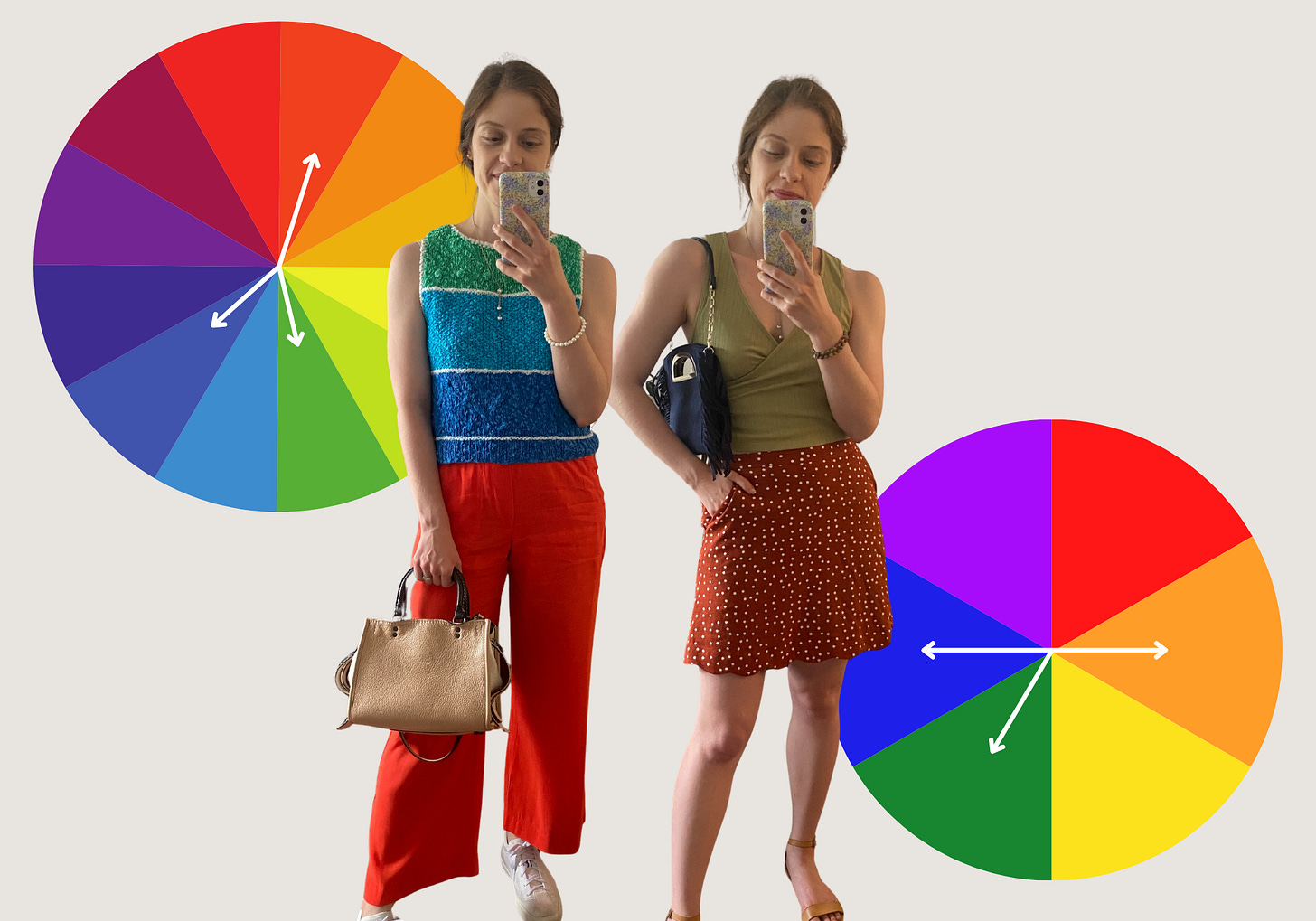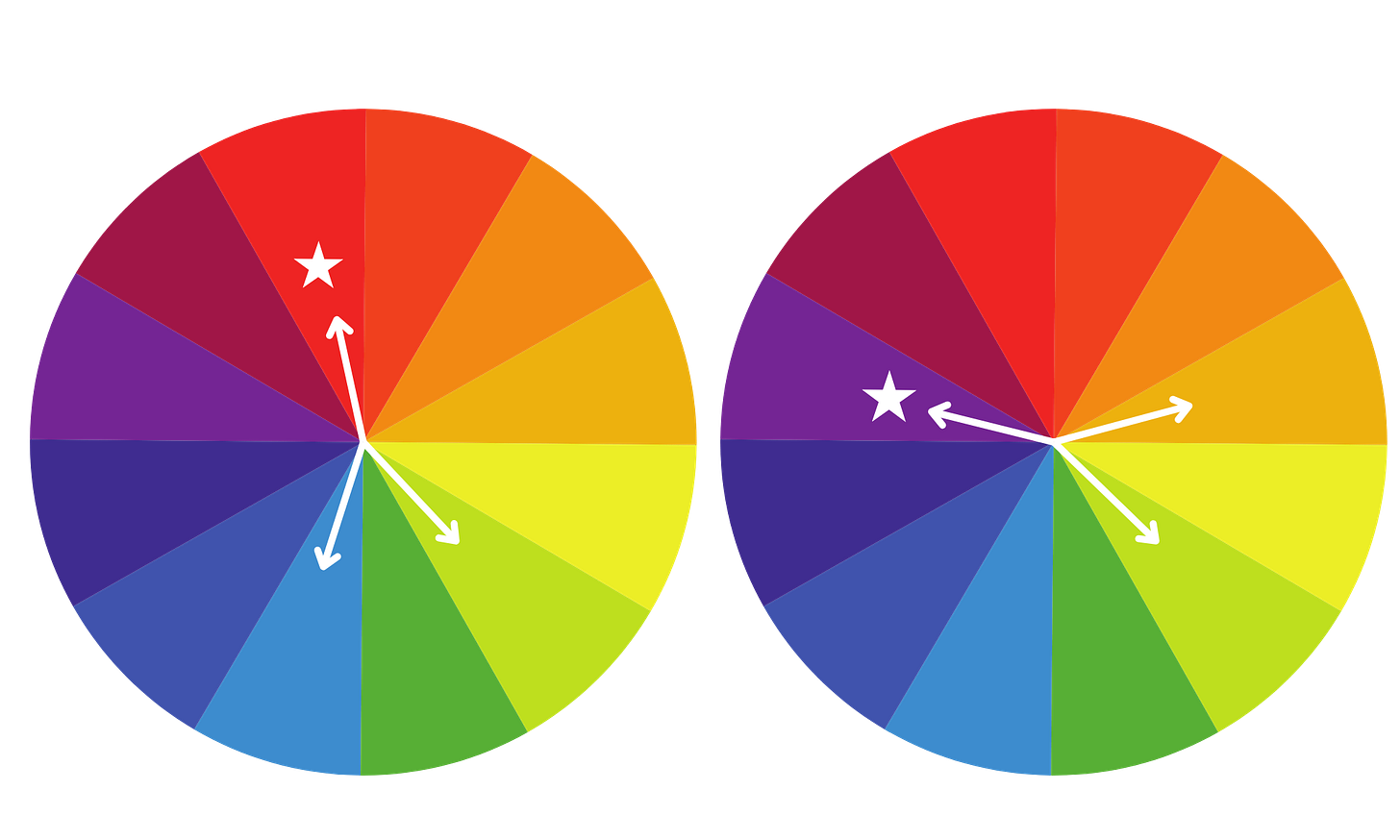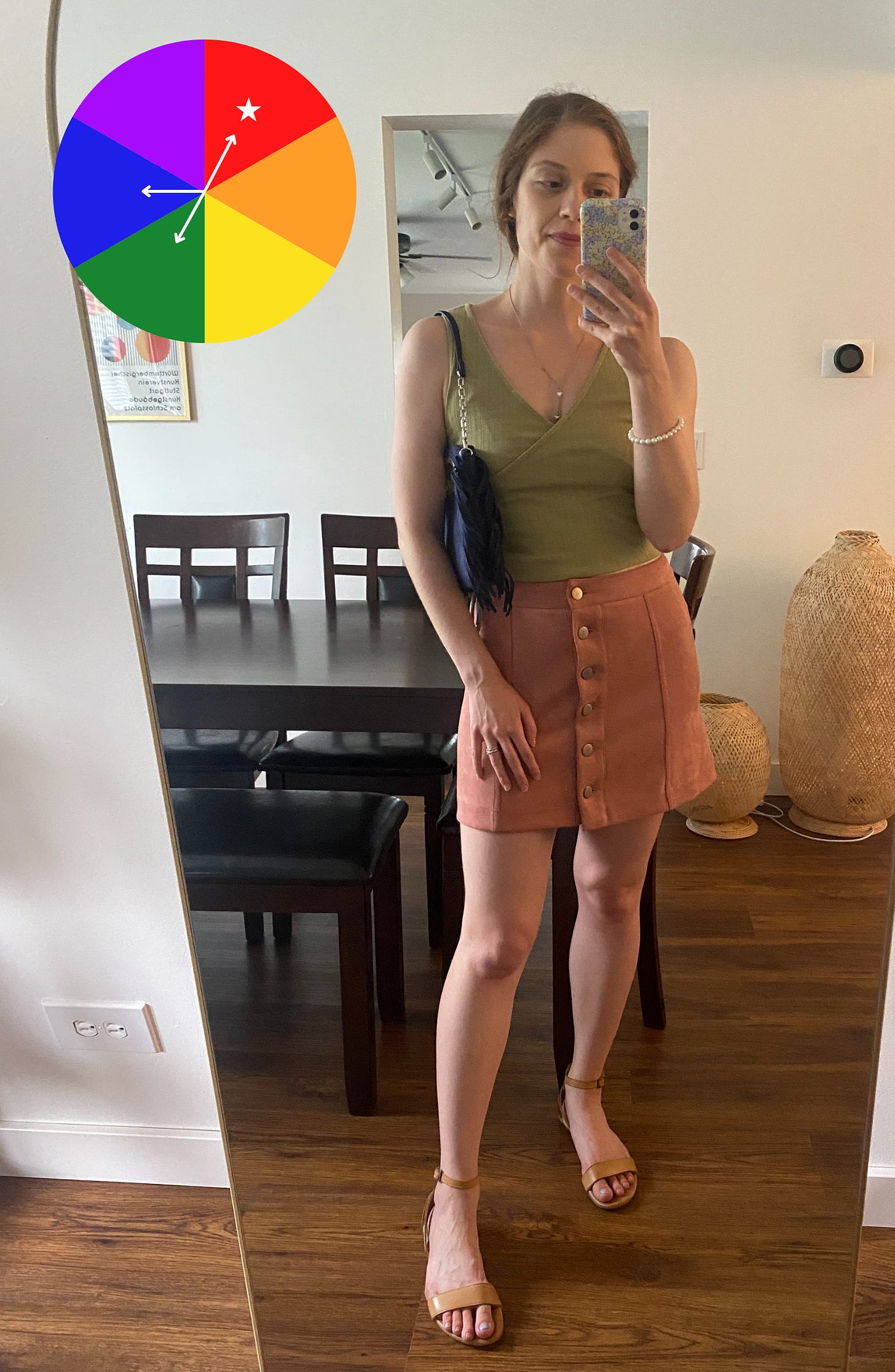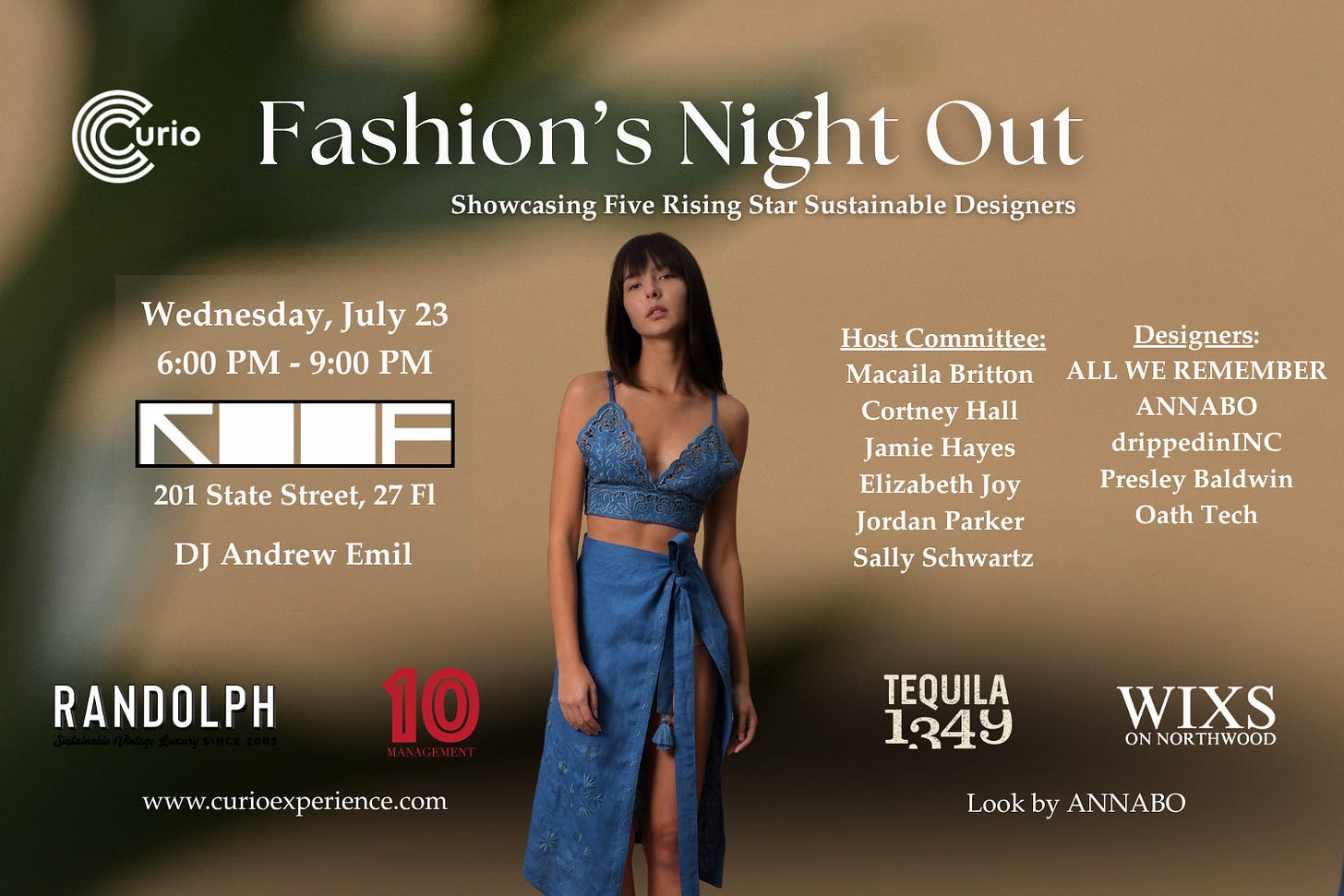Welcome back to another edition of Color Theory Outfit Combinations —
Where we explore how to look at colors in new ways to remix what you already have.
When it comes to putting together outfits each day, it can be tempting to turn to the same formulas we've been used to: jeans and a tee, blouse and a neutral pair of trousers, a dress and a nude shoe.
There's nothing wrong with these formulas at all — but if you're feeling a bit bored of your wardrobe, it could be time to switch it up.
We've been trained to think boredom equals “I need to buy something else", but I've learned (the hard way) that shopping from urgency doesn't usually lead to great long-term purchasing decisions.
Boredom is more often than not simply a sign to think about your clothes in fresh ways — and that's exactly why this color theory series exists. (And because color can bring us a dose of joy in our daily lives, even if it is in small doses.)
As a quick recap:
In part one, after setting the foundations of color theory, we explored how to master monochrome — including tonal — outfits.
Part two ventured slightly from one color into analogous dressing (colors next to each other on the color wheel).
And part three went the opposite direction into complementary colors (pairings from opposite sides of the color wheel).
Now that we have the basic color schemes covered, we're heading into more advanced color schemes — but I promise it can still feel approachable.
Today: the split complementary color scheme.
Introducing Split Complementary
According to color theory,
a split complementary color scheme features one main color and the two colors adjacent to its complement color.
For example, if you chose red as a base color, its complement would be green — so the split complementary colors would be a green-yellow and a green-blue.
Or if purple is your base color, the complement is yellow. Its split complementary colors would be right next to yellow: yellow-orange, and yellow-green.
We see this color scheme being applied everywhere from graphic design to interior design — so naturally, we can also apply it to our outfits.
Before you hear about a 3-hue color scheme and think “but I don't like to wear that much color!” hear me out…
Split complementary colors make a color palette feel dynamic but in a more nuanced way that true complementary colors.
And as we've explored in previous parts of this series, color doesn't have to mean saturated or bright. We can explore desaturated, softer, or deeper versions of all hues.
One final point to make my case: adding more colors doesn't always mean more contrast. In fact adding in an additional hue that's in the same neighborhood as one of the other colors can even tone down the contrast.
How to Apply Split Complementary to Outfits
While we could master this scheme perfectly if we were working with digital colors, it's not easy to be exact with this color scheme in an outfit.
So here are several options — ranked from challenging to easy — to implement this color scheme into your outfits.
The “true” way (level: challenging)
Pick a base color (like red-orange)
Find it's opposite (that would be blue-green)
Bring in the colors that sit to the right and to the left of the complement on the color wheel (that would be green and blue)

The modified approach (level: medium)
We can take a looser approach and venture slightly outside of the exact neighboring colors from the complement. I’m guessing you probably don't own every one of the primary, secondary, and tertiary colors on the color wheel!
In this outfit I picked the same base of the red-orange pants. Then I added in a yellow-green top and a dark blue (almost blue-purple) bag. These colors aren't exactly next to the complement as you can see in the color wheel, but they're close. The idea is that we're adding in more flexibility here.

The simplified approach (level: easy)
If this is feeling overwhelming or unrealistic with your closet, let's just make it super straightforward and combine two concepts we've already covered: complementary and analogous.
And let's just forget about all of those tertiary in-between colors (like blue-green, yellow-orange, purple-red) for now and use a basic color wheel.
Here's a super approachable version of this idea:
Pick a base color (like orange)
Find its complement (that would be blue)
Add the analogous neighboring color (like green)

We could also go the other direction with the analogous color. The another color analogous to blue on the simplified color wheel is purple.

I'll bring in a different base example to further illustrate this color scheme outfit idea.
As a new base, I'll pick out my pink skirt.
Here's how I'd go through this process.
Base color: pink.
Complement: Since pink is just a lighter version of red, the opposite color on the basic color wheel is green.
Analogous to the complement: the colors right next to green on the simple color wheel are either blue or yellow, but I don't own any yellow so let's do blue.
The idea is less about being exact with the hues on the color wheel, and more about harnessing the color wheel to inspire new palettes you can create within your closet.
Your challenge this week:
Implement one of these approaches to split complementary colors!
Easy version: Pick a base piece in a color. Imagine (or look at) the simple color wheel and find what the complement is and add that into the outfit. Then, add a third color that sits right next to the complement.
Hard mode: Look at the full color wheel. Pick a base piece in a color and look at what the complementary color is. Then add in the two colors that are adjacent to that complement.
Will you try it? Let us know about it in the comments. 😊
That rounds out part 4 of Color Theory Outfit Combinations…
What's coming next? Part five where we'll explore another advanced color scheme from color theory.
I also have some newsletters in the works on identifying “sustainable” materials and how to determine quality. You won't want to miss these. 👀
Thanks for reading!
xx Elizabeth
P.S. We just finished the beta of the Love Your Closet Again live course this week! And students are saying things like:
“Of all the things I've tried, this gave me the biggest boost on my slow fashion journey!”
➡️ Want to be the first to know when the course opens again? Join the waitlist here.
✨ Attending: Fashion's Night Out (Chicago)
Local indie designers need our support more than ever, so I'm thrilled to be on the host committee for this event celebrating sustainable designers in Chicago. In addition to highlighting designs from five rising star designers, the event will feature a cocktail hour and opportunity to network with Chicago fashion folks. See you there?!
📖 Reading…
Who Gets Protected, and Who Doesn’t? Cotton and Labour |
The cotton industry is rife with exploitation — but this is nothing new. This post from Cotton Diaries gives us historical context for gaps in labor rights in the industry.
Abbott says megafloods are “just part of nature.” The fossil fuel industry disagrees. | x HEATED with
The fossil fuel industry has been taking climate science seriously — at least when it comes to protecting its own operations — for a long time. Major companies including Exxon, Mobil, and Shell began preparing their own infrastructure for big storms and rising seas decades ago, even while battling regulations to curb the use of fossil fuels.
What's the deal with Quince? |
I keep seeing this brand on “sustainable fashion” roundups. But the prices they charge given the materials they say they use… well, it's felt quite suspicious. This breakdown from
helps explain Quince and the business model of dupes.📺 Watching:
Style Inspiration is Everywhere |
I love Alyssa's approach to harness style creativity from anywhere, not just by looking at other outfits on Pinterest. While the internet can be helpful, you could also look to nature, art, architecture, and even food to inspire outfits. This taps into the kind of creative inspiration fashion designers often use for their collections.
That's all for this week's roundup — see you again next week!










Wait this is so fascinating!! You broke it down really easily, I’m definitely going to have to try this out. Consider me inspired, thank you! 🌈 👗
Thank you for the mention, a lovely round up of reads ❤️📖